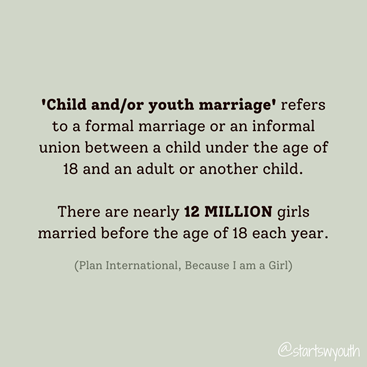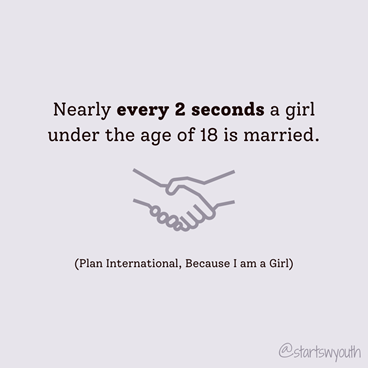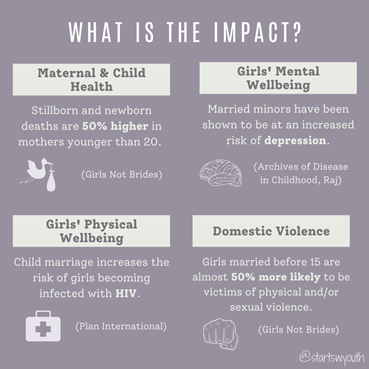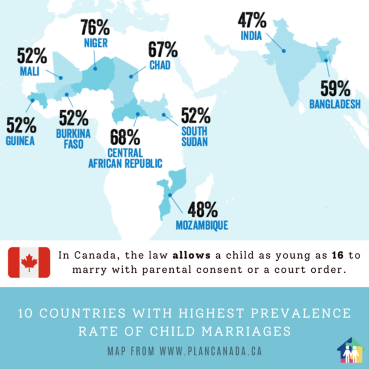Building on her HIST 515 Independent Research Paper, Prishni Seyone has officially launched the social media awareness campaign of her organization, Starts With Youth. The campaign will run from May 10th to May 29th, bringing awareness about child marriage and its global history while creating a space for survivors and allies. View the campaign on Instagram, Facebook, and LinkedIn, @startswyouth.
Prishni Seyone is the 2020 winner of the Prendergast-Rivard Studentship Award and completed her HIST 515 research paper, "The Indian Girl-Wife: Not Even a Woman, but Already a Wife," under the supervision of Dr. Ishita Pande. We asked Prishni to tell us more about the Starts With Youth social medial campaign and her research.
Documenting History
I. Introduction: Starts With Youth
Studies indicate that 1 in 3 of those who are abused in childhood grow up to become abusers themselves. To me, this statistic is both tragic and hopeful. It’s tragic because much too many children are suffering at the mercy of their loved ones, but hopeful, because the solution is in the stat. Our society currently approaches child welfare as interventionists - We intervene when a child is hurt but what about stopping the child from being hurt in the first place? By raising awareness about childhood abuse and trauma and encouraging community-wide education and resource referral amongst survivors, Starts With Youth strives to create a generation of current and future caregivers that are aware of the effects of their own trauma, are able to reach out for help, and are overall, better equipped to be their best self for their kids. In this vein, Starts With Youth embodies the discipline of history and the practice of recognizing our mistakes.
 Currently, Starts With Youth strives to achieve our vision through our blog on www.startswithyouth.com, and through our social media platforms on Instagram, Facebook, and LinkedIn, @startswyouth. We aim to wield the technology at our fingertips for good, to circulate information that will increase societal awareness about what is healthy love, and to give individuals a safe space to engage with the topic of intergenerational trauma. Since launching a little over a year ago, Starts With Youth has amassed a following of over 2,000 individuals from around the world, with a single one of our Instagram posts reaching about 900 people daily. We publish weekly articles and infographics that discuss different topics related to abuse and trauma; these topics range from descriptions of what child sexual abuse is to our “SWY Book Club” where we discuss related media material. We also release weekly interviews with survivors, experts in the field, and organizations doing relevant work. We have had the opportunity to feature a diversity of incredible individuals on our platform, including Florida State Senator, Lauren Book.
Currently, Starts With Youth strives to achieve our vision through our blog on www.startswithyouth.com, and through our social media platforms on Instagram, Facebook, and LinkedIn, @startswyouth. We aim to wield the technology at our fingertips for good, to circulate information that will increase societal awareness about what is healthy love, and to give individuals a safe space to engage with the topic of intergenerational trauma. Since launching a little over a year ago, Starts With Youth has amassed a following of over 2,000 individuals from around the world, with a single one of our Instagram posts reaching about 900 people daily. We publish weekly articles and infographics that discuss different topics related to abuse and trauma; these topics range from descriptions of what child sexual abuse is to our “SWY Book Club” where we discuss related media material. We also release weekly interviews with survivors, experts in the field, and organizations doing relevant work. We have had the opportunity to feature a diversity of incredible individuals on our platform, including Florida State Senator, Lauren Book.
The outcome Starts With Youth hopes to see with our work is an improvement in family relationships and healed adult children, and as a result, a future generation that is less traumatized and better equipped to take on the world. Traumatized children make up a majority of our homeless population, our crime and prison rates, and those struggling with addiction and mental health; if we help fix families so that less children are suffering at the mercy of those meant to protect them, perhaps we can also reduce the prevalence of other issues infiltrating our society.
II. Child Marriage Campaign
 Although my historical research throughout my 515 term was primarily focused on the prevalence of child marriage throughout India in the late nineteenth and early twentieth century, the practice is very much enduring in the present day. According to Government of Canada data, there are currently more than 650 million women and girls who were married as a child or adolescent in the world today.
Although my historical research throughout my 515 term was primarily focused on the prevalence of child marriage throughout India in the late nineteenth and early twentieth century, the practice is very much enduring in the present day. According to Government of Canada data, there are currently more than 650 million women and girls who were married as a child or adolescent in the world today.
As Starts With Youth continues to grow and develop a following, I often reflect on our own role, and more so, responsibilities, as documenters of history. In order to effectively encourage more young people to recognize the ways in which they may be affected by intergenerational trauma, I believe the first line of intervention is education. Starts With Youth aims to foster education about the topic through a variety of different means, namely our Instagram infographics and most recently our “Teacher page”, expertly created by two teacher candidate placement students during their alternative practicum experience with us.
In the development of all our educational resources, I strive to be conscious of my lessons in historiography, to ensure that I am being critical of sources and the biases that may be reflected in them, as well as in my own judgment. While working on my 515 throughout this year, I often found that my research complemented my work with Starts With Youth. In attempting to understand the history of my own family, I was also unpacking an intergenerational trauma afflicting the South Asian community, as well as many other ethnic groups around the world.
 Using my gathered 515 research as well as additional present-day references, I have developed a three-week campaign about child marriage that is scheduled to run on Starts With Youth’s social media platforms from May 10th to May 29th, 2021. As outlined below, this campaign will consist of three sets of carousel infographics, as well as individual survivor testimony graphics that will be posted intermittently. The purpose of this campaign is two-fold; firstly, the campaign intends to raise awareness and educate our following about child marriage, specifically about its global history, related myths that exist, and its present-day occurrence.
Using my gathered 515 research as well as additional present-day references, I have developed a three-week campaign about child marriage that is scheduled to run on Starts With Youth’s social media platforms from May 10th to May 29th, 2021. As outlined below, this campaign will consist of three sets of carousel infographics, as well as individual survivor testimony graphics that will be posted intermittently. The purpose of this campaign is two-fold; firstly, the campaign intends to raise awareness and educate our following about child marriage, specifically about its global history, related myths that exist, and its present-day occurrence.
Secondly, the purpose of this campaign will be to create a space for survivors and allies to come together and feel supported, seen, and heard. I plan to accomplish this through interactive and engaging captions and story question boxes that will allow survivors and allies to comment, anonymously or not, in relation to the topic. I have also worked to share resources that those in need or interested may turn to, in order to encourage those who may be affected by early marriage to reach out for help and share their struggles with someone trusted. Although not confirmed, I also hope to run an Instagram Live Q&A event with an advocate and/or organization, such as Samra Zafar or Girls Not Brides, in order to provide our followers with the opportunity to engage with an expert.
Although I am still skeptical about social media’s benefits sometimes, I believe it also possesses an incredible power to make information, and specifically history, accessible. When designing this campaign about child marriage, I aimed to be cognizant of different learning styles, understandings, and limitations. I believe these reflections are necessary in order to accomplish what I believe is the core goal of education, the effective dissemination of information. By creating graphics with varying text length and type, and by incorporating a variety of different multimedia formats, such as Instagram infographics, story polls, and a virtual event, I hope that awareness is fostered throughout a wide audience. This diversity of audience is particularly important as it will ensure that more people are equipped to intervene, should someone they know be forced into an early marriage.
 Throughout this campaign, I have been careful not to frame the issue of child marriage through an ethnic lens. Although my 515 focused on the specific experiences of Indian women, the campaign graphics created aim to shed light on the experiences of victims and survivors around the world. Often falsely viewed as an exclusively South Asian issue, I believe that the ethnic diversity of child marriages is important to call attention to, and demonstrates the impact of biases and privilege on the documentation of history. A topic often discussed throughout my degree is the ways in which we can uncover the marginalized voices in histories that have been largely developed through an oppressive, privileged lens. This reflection on the structures that shape our public historical knowledge has always fascinated me, and in the case of Starts With Youth, has ensured that when contributing to the dissemination of information, I do so in a way that is cognizant of and uplifts the diversity of experiences that exist.
Throughout this campaign, I have been careful not to frame the issue of child marriage through an ethnic lens. Although my 515 focused on the specific experiences of Indian women, the campaign graphics created aim to shed light on the experiences of victims and survivors around the world. Often falsely viewed as an exclusively South Asian issue, I believe that the ethnic diversity of child marriages is important to call attention to, and demonstrates the impact of biases and privilege on the documentation of history. A topic often discussed throughout my degree is the ways in which we can uncover the marginalized voices in histories that have been largely developed through an oppressive, privileged lens. This reflection on the structures that shape our public historical knowledge has always fascinated me, and in the case of Starts With Youth, has ensured that when contributing to the dissemination of information, I do so in a way that is cognizant of and uplifts the diversity of experiences that exist.
